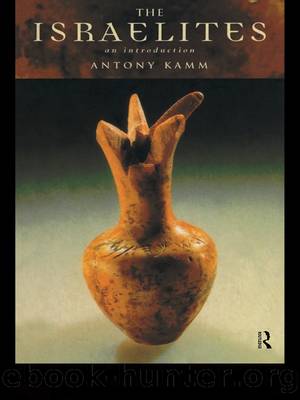The Israelites by Kamm Antony

Author:Kamm, Antony. [ANTONY KAMM]
Language: eng
Format: epub
Publisher: Taylor & Francis Ltd
Published: 2011-09-30T16:00:00+00:00
HOUSE AND HOME
The tents of the original Israelites were of black goatskin, supported by guy ropes pegged or staked into the ground. They might be divided by hangings into two or more rooms; women and guests sometimes had separate tents. In later times tents were used by herdsmen and by the army on active service. The ascetic Israelite sect, the Rechabites, who were strictly teetotal and did not own property or cultivate the fields, maintained the ancient tradition by living in tents away from urban areas. Claiming descent from Jonadab, son of Rechab, who was Jehuâs travelling companion when the surviving kin of Ahab were slaughtered, they were still active in their way of life in the time of Jeremiah 250 years later.
The houses of the Israelites were simple affairs of mud bricks and wood, on solid foundations of stones or broken rock, with flat roofs of clay on brushwood, reached by an outside ladder or staircase and maintained by periodic flattening with a cylindrical stone roller. The roof was an excellent place to dry the washing, to congregate in the cool of the evening, and to converse with your neighbours across the narrow street. That safety precautions were required is attested by Deuteronomy 22:8: âWhen you build a new house, you shall make a parapet for your roof, so that you do not bring bloodguilt on your house if anyone should fall from it.â Cooking would have been done as far as possible out of doors, because of the smoke from the fire. Animals bedded down with the humans or, in larger houses, which might also have an upper floor, were stabled behind a line of pillars down each side. Beds were only for special guests. Thus when the rich woman of Shunem prepares to have Elisha as a periodic lodger, she puts in his room âa bed, a table, a chair and a lampstandâ (2 Kings 4:10). Normal seating was the floor or a stone ledge along an inside wall of the house, such as was used by Saul and leading members of his household (1 Sam. 20:25). There is archaeological evidence that some rural houses had individual underground water cisterns, dug out of the rock.
Town houses for the rich were suitably palatial and were sometimes built round a courtyard. Poorer citizens lived in separate quarters of the town in standardised boxes, crammed together. Problems were heat, cold, winter rains, insects, and dirt.
Biblical homilies about cleanliness, however, are not confined to the spiritual implications of the term. Indeed the scholarly rabbis whose contributions to the exegesis of the Torah, collected between about 400 and 500 CE, comprise the Talmud, interpret references in Leviticus 11 to include also things which are naturally distasteful, such as unwashed bodies, dirty platters, and putrescent food, as well as the eating of flesh which may be objectionable for other reasons. The soothing and cleansing of feet by bathing them on entering a tent or house was a tradition with a practical application when
Download
This site does not store any files on its server. We only index and link to content provided by other sites. Please contact the content providers to delete copyright contents if any and email us, we'll remove relevant links or contents immediately.
The Lost Art of Listening by Michael P. Nichols(7163)
Why I Am Not A Calvinist by Dr. Peter S. Ruckman(4045)
The Rosicrucians by Christopher McIntosh(3371)
Wicca: a guide for the solitary practitioner by Scott Cunningham(3043)
Signature in the Cell: DNA and the Evidence for Intelligent Design by Stephen C. Meyer(2878)
Real Sex by Lauren F. Winner(2864)
The Holy Spirit by Billy Graham(2775)
To Light a Sacred Flame by Silver RavenWolf(2674)
The End of Faith by Sam Harris(2632)
The Gnostic Gospels by Pagels Elaine(2397)
Waking Up by Sam Harris(2330)
Nine Parts of Desire by Geraldine Brooks(2280)
Jesus by Paul Johnson(2226)
Devil, The by Almond Philip C(2204)
The God delusion by Richard Dawkins(2187)
Heavens on Earth by Michael Shermer(2187)
Kundalini by Gopi Krishna(2092)
Chosen by God by R. C. Sproul(2054)
The Nature of Consciousness by Rupert Spira(1980)
